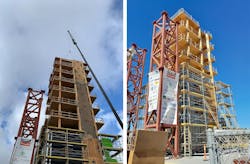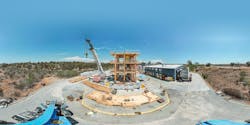First-of-its-kind shake test concludes mass timber’s seismic resilience
By Quinn Purcell, Managing Editor
Last month, a seismic shake test was conducted on a 10-story wooden structure—the world’s tallest building to be tested on a shake table earthquake simulator. The goal? To validate the strength of mass timber products during simulated earthquake conditions.
The two tests were successfully conducted at the University of California, San Diego (UCSD) on May 9. As part of the Natural Hazard Engineering Research Infrastructure (NHERI) Tall Wood Project, the mass timber building was designed by LEVER Architecture and developed as a market rate prototype.
The 10-story mass timber building design
The 112-ft structure was largely built using donated mass timber products, including Cross Laminated Timber (CLT), Mass Plywood Panel (MPP), Nail-Laminated Timber (NLT), Dowel Laminated Timber (DLT), Veneer Laminated Timber (VLT), and Glulam. The design featured rocking walls that allowed the building to recenter itself during a seismic event. Additionally, post-tensioned steel rods on each floor were included to absorb the brunt of the seismic force.
The building featured four exterior façade assemblies, a number of interior walls, and a 10-story stair tower, to test the impact to safety-critical nonstructural components as well.
Mass timber shake test results
How did the building fare, then? The May 9 test simulated two previously recorded earthquakes—a magnitude 6.7 earthquake from 1994, and a 7.7 earthquake recorded in Taiwan circa 1999. UCSD’s shake table—the largest shake table in the world—measured 25 ft by 40 ft. Due to the building’s rocking wall lateral system, the building suffered minimal damage. The research partners believe a mass timber building like this would be quickly repairable after similar earthquakes.
Though the full findings of the test won’t be released until later this year, the project team believes this building type will be an answer to addressing urbanization demand while enhancing resilience and sustainability. While this test focused on seismic viability, the team will now deconstruct the top four floors of the building for research on mass timber deconstruction. Oregon State University will do additional tests to gather data for end-of-life reuse of mass timber.
NHERI TallWood seismic test project partners
In addition to University of California San Diego, a number of universities collaborated on the project, including the Colorado School of Mines; the University of Nevada, Reno; Colorado State University; the University of Washington; Washington State University; Oregon State University; and Lehigh University.
The NHERI TallWood project was funded by the U.S. National Science Foundation; it received support from the USDA Forest Products Laboratory and the U.S. Forest Service, as well as additional building industry partners including Construction Specialties, Simpson Strong-Tie, and JMC² Civil + Structural Engineering. The structure’s Mass Ply shake walls were supplied by Freres Engineered Wood.


